After Madame LaLaurie was run out of New Orleans for torturing her enslaved workers, her mansion became one of America's most "haunted" houses.
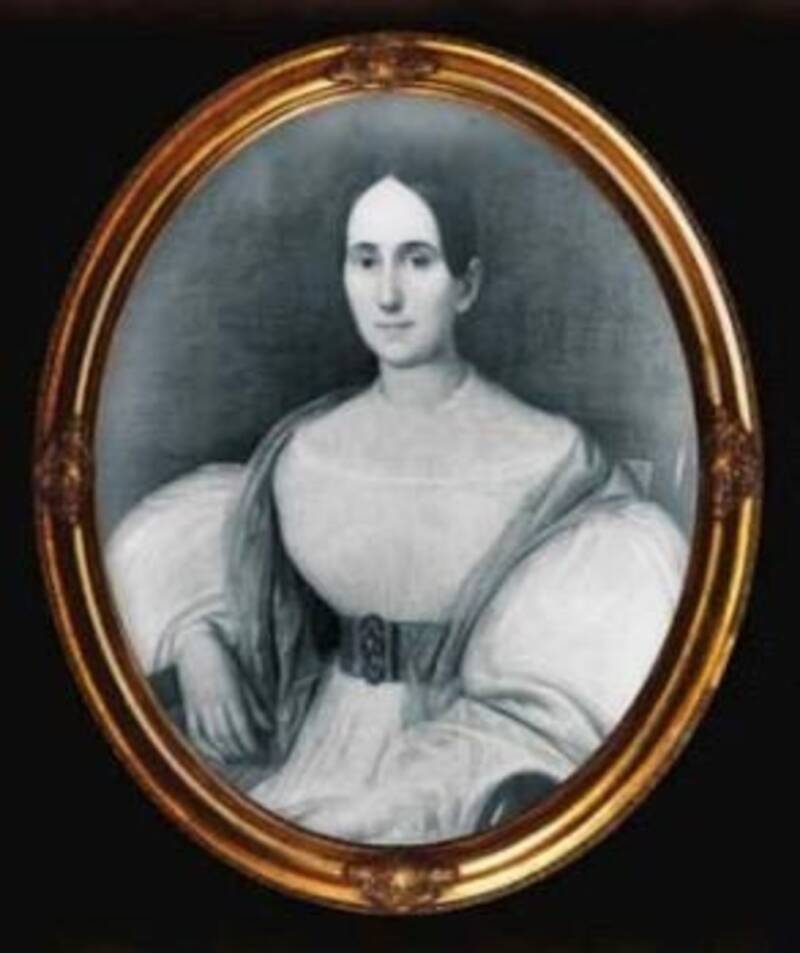
Wikimedia CommonsWhen locals entered Madame LaLaurie’s mansion after a fire in 1834, they found her enslaved workers, some of them horribly mutilated and just barely clinging to life, while others were dead and simply left to decompose.
In April 1834, a fire broke out at the New Orleans mansion owned by socialite Madame LaLaurie and her husband. Locals rushed to help — and discovered shocking proof of her deranged depravity.
Though the two-story home at 1140 Royal Street looked beautiful from the outside, Madame LaLaurie had been cruelly and systematically torturing countless enslaved people there for years. When volunteers entered the house to help put out the fire, they not only found a cook chained to the stove, but numerous disfigured enslaved people in the attic.
The horrors they discovered would forever change the public’s perception of Madame Delphine LaLaurie, once known as a respectable member of society — and now known as the Savage Mistress of New Orleans.
Madame LaLaurie Before She Turned Her Mansion Into A House Of Horrors
Before she became Madame LaLaurie, she was born Delphine Macarty (sometimes spelled MacCarthy) on March 19, 1787, in New Orleans. She came from a wealthy family who owned a sprawling 1,344-acre plantation, and her mother was well known for throwing wild, extravagant parties.
When Delphine was just 14 years old, she married her first husband, 35-year-old Ramon López y Ángulo de la Candelaria in 1800. But the marriage was short-lived. Five years later, and while Delphine was pregnant with the couple’s child, her husband perished in a shipwreck off the coast of Cuba.
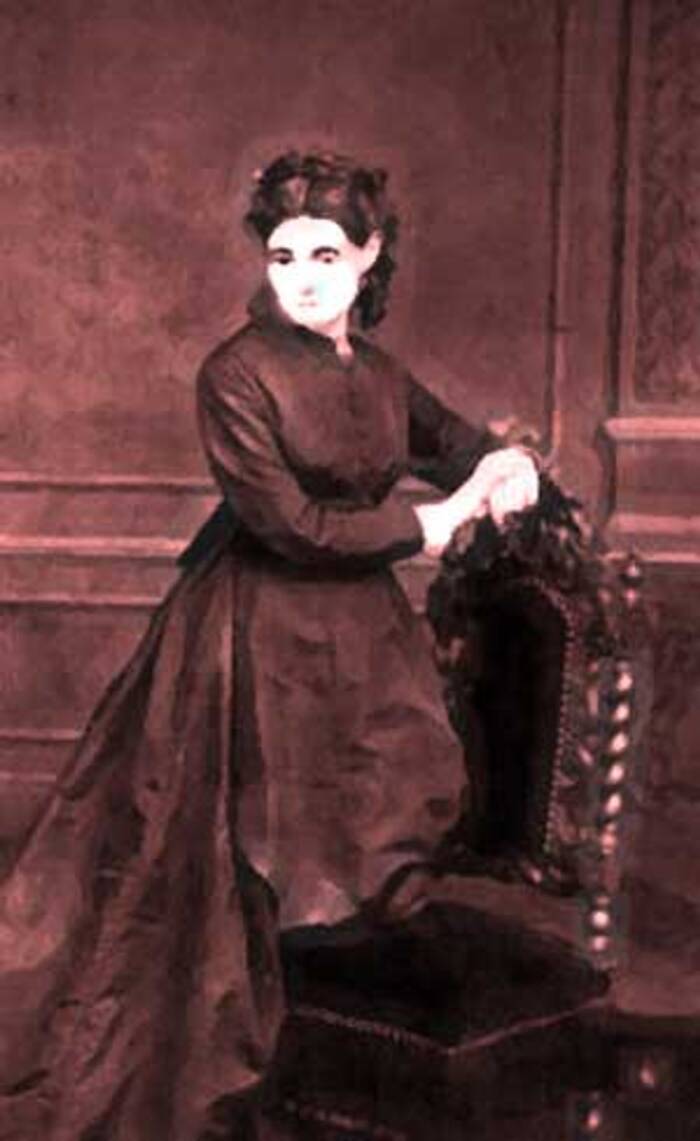
Public DomainA portrait that purportedly depicts Madame Delphine LaLaurie.
When Delphine was 20, she married her second husband, Jean Paul Blanque. They had four children together, but this marriage, too, ended in tragedy. When Delphine was 28, her 50-year-old husband suddenly died. Blanque left his widow deeply in debt, which was only alleviated after the death of Delphine’s father in 1824, as he had left her a sizable inheritance.
Then, in 1826, Delphine began a romance with the younger French chiropractor Dr. Louis LaLaurie after one of her children had an appointment with him. At the time, Delphine was 38 and Louis was in his early 20s. Shortly after she gave birth to their son, they married in 1828.
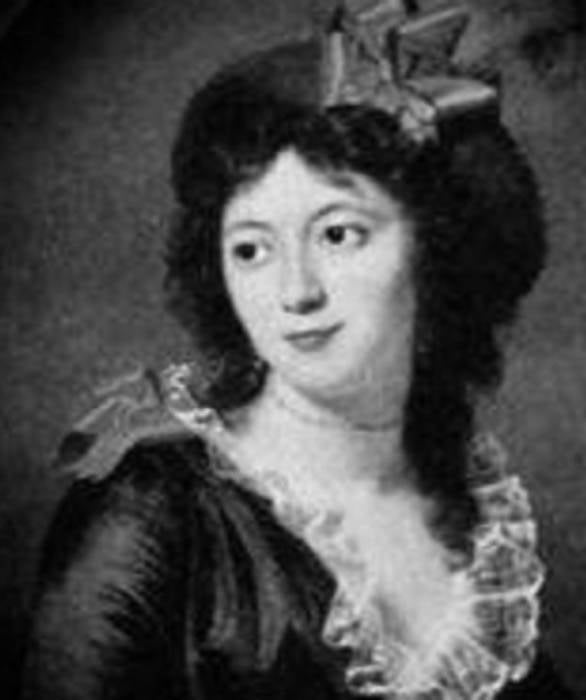
Public DomainAnother possible depiction of Madame LaLaurie.
However, their marriage was reportedly not a happy one. The couple was known to frequently separate and reconcile. Despite this, the pair purchased a handsome, unfinished home at 1140 Royal Street in New Orleans’ French Quarter. They completed the LaLaurie Mansion in the Federal architectural style, and it appeared to be an attractive addition to the neighborhood.
Few could have imagined the horrors that unfolded within.
Grisly Rumors Begin To Surround The LaLaurie Mansion
With Louis LaLaurie frequently out of town, the home at 1140 Royal Street was usually occupied by Madame Delphine LaLaurie, her children, and numerous enslaved people. Before long, rumors began to spread about Madame LaLaurie’s treatment of her enslaved workers, with some suspecting that she was going far beyond punishments that were legally permitted in New Orleans (which were already extremely inhumane as is).
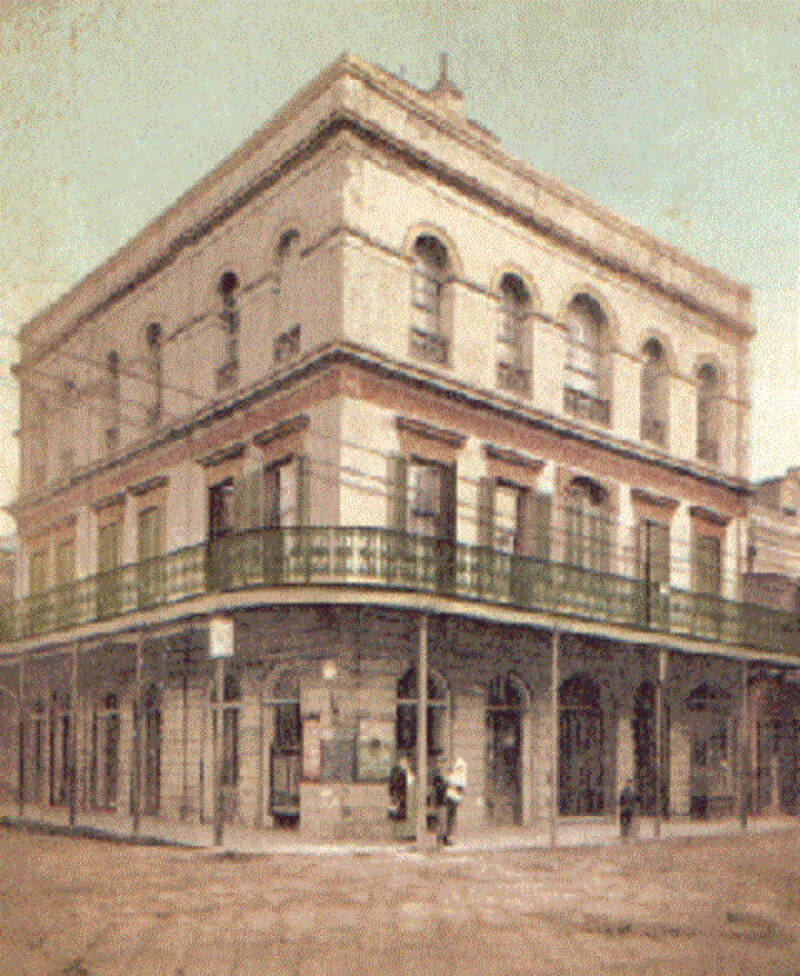
Public DomainThe LaLaurie Mansion, as seen in a 1906 postcard.
Though Madame LaLaurie acted kindly toward slaves in public (and even freed two of them), some believed that things were different behind closed doors. For one, enslaved people living at LaLaurie Mansion often seemed “singularly haggard and wretched,” according to locals. Whispers about Madame LaLaurie’s cruel treatment reached such a pitch that a lawyer went to investigate, though he allegedly found no signs of mistreatment.
But in some cases, Madame LaLaurie’s depraved treatment of enslaved people was all too obvious to her concerned neighbors.
At one point, a 12-year-old enslaved girl named Lia pulled a bit too hard while brushing Madame LaLaurie’s hair. In response, LaLaurie flew into a rage. She chased the terrified girl throughout the house with a whip and up onto the roof, where Lia ran to the edge and tumbled to her death.
Madame LaLaurie purportedly tried to cover this up by dumping Lia’s body in a well, but there were enough witnesses that the authorities came to investigate. They found Madame Delphine LaLaurie guilty of illegal cruelty and forced her to forfeit nine enslaved people as a result. However, LaLaurie found a way around the punishment. She had her family members and friends purchase the enslaved people, and sell them back to her.
Still, much more terrible things were happening at the LaLaurie Mansion. But no one knew about the true depths of Madame LaLaurie’s depravity until a fire suddenly broke out at her home in April 1834.
What Really Happened Inside Madame LaLaurie’s Mansion?
When the blaze first started on April 10, 1834, a group of locals raced to LaLaurie Mansion to help put it out. But after Madame LaLaurie and her guests fled the home, the volunteers came across a shocking sight.
In the kitchen, they found a 70-year-old emaciated cook chained to the stove. As the cook later admitted, she had started the fire on purpose. (Some sources claim the cook did this to die by suicide, while others state that the cook had hoped to draw attention to the abuse in the home.)
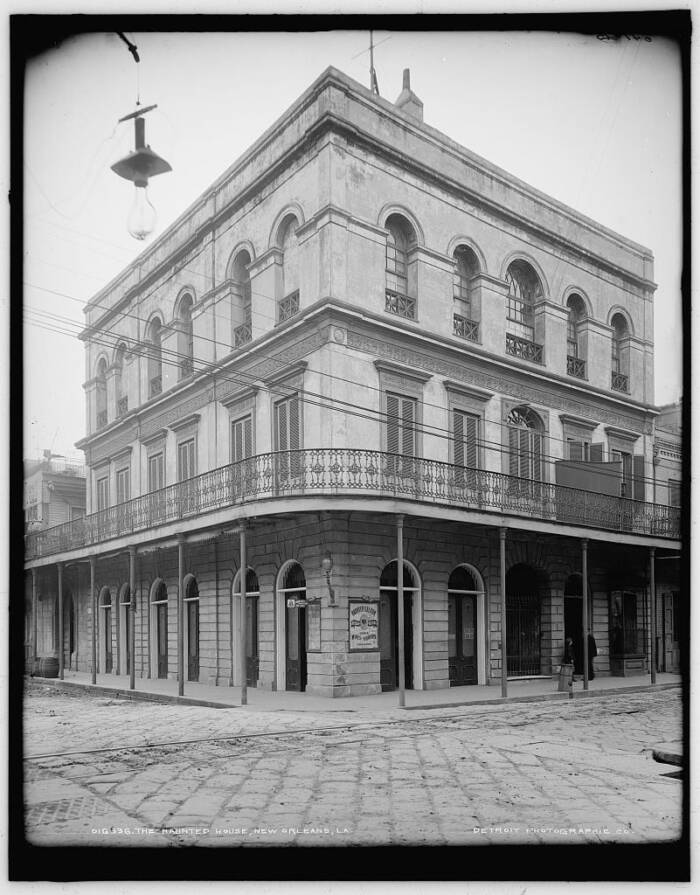
Public DomainMadame LaLaurie’s mansion. Circa 1900.
This was the first clue that something was wrong at LaLaurie Mansion. But the volunteers would soon find something much more gruesome.
The volunteers eventually made their way to the attic, where they were greeted by “the most appalling spectacle,” according to an April 11, 1834 article from the local newspaper The New Orleans Bee. As the paper reported, “Seven slaves more or less horribly mutilated were seen suspended by the neck, with their limbs apparently stretched and torn from one extremity to the other… They had been confined by her for several months… and had been merely kept in existence to prolong their suffering.”
Perhaps most horrific, these enslaved people — who were barely still alive — were found among the bodies of slaves who’d already been murdered. Some victims were tied to tables; others were confined in tiny cages. One had her limbs broken and reset so that she resembled a crab, some had their mouths sewn shut, and others had their eyes gouged out.
One witness even claimed that there were people with holes in their skulls, and wooden spoons near them, presumably used to stir their brains.
Even by the brutal standards of American slavery, this was considered horrific. As an outraged mob assembled outside of LaLaurie Mansion, however, Madame LaLaurie was able to slip into her carriage and escape.
What Became Of Madame Delphine LaLaurie After Her Crimes Were Exposed?
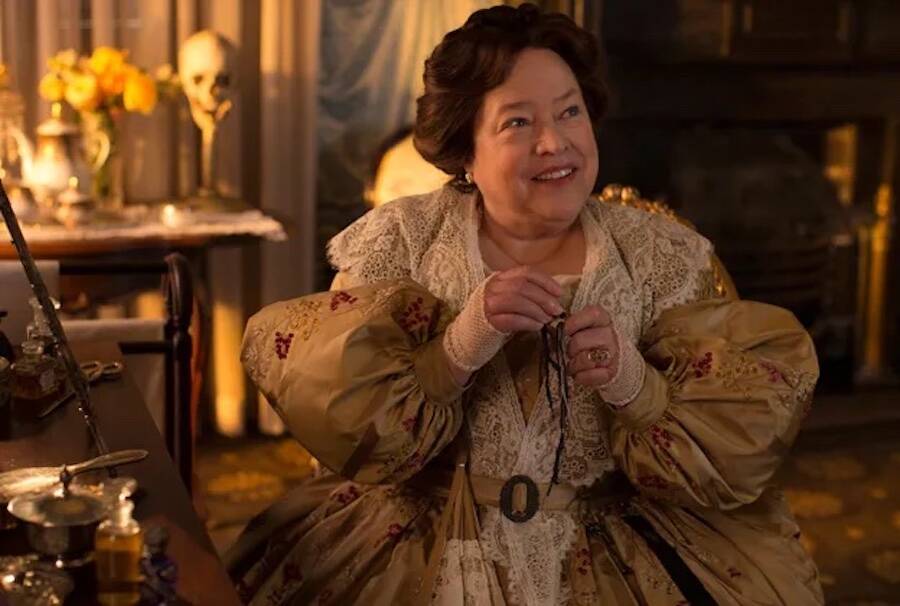
Michele K. Short/FXMadame LaLaurie was famously portrayed by Kathy Bates in American Horror Story: Coven.
In the aftermath of Madame Delphine LaLaurie’s escape, she purportedly made her way onto a schooner in Lake Pontchartrain. Later on, in June 1834, an American poet allegedly crossed paths with her on a vessel that was sailing to France.
He described meeting “a pretty-looking French woman… a Madame LaLaurie.” Apparently, Madame LaLaurie had been unable to keep what happened at the LaLaurie Mansion a secret, because he added that she had “committed such horrible cruelties upon her slaves… in New Orleans” and that several of her enslaved workers had been discovered “confined, some chained in painful postures and others horribly wounded and scarce alive.”
Despite her ghastly confessions, she apparently made it to Paris, where her husband and her children reportedly later joined her. She purportedly died there on December 7, 1849, at the age of 62. Ghost City Tours reports that her body was later exhumed and sent to New Orleans, where her epitaph plate was allegedly discovered at the St. Louis Cemetery No. 1.
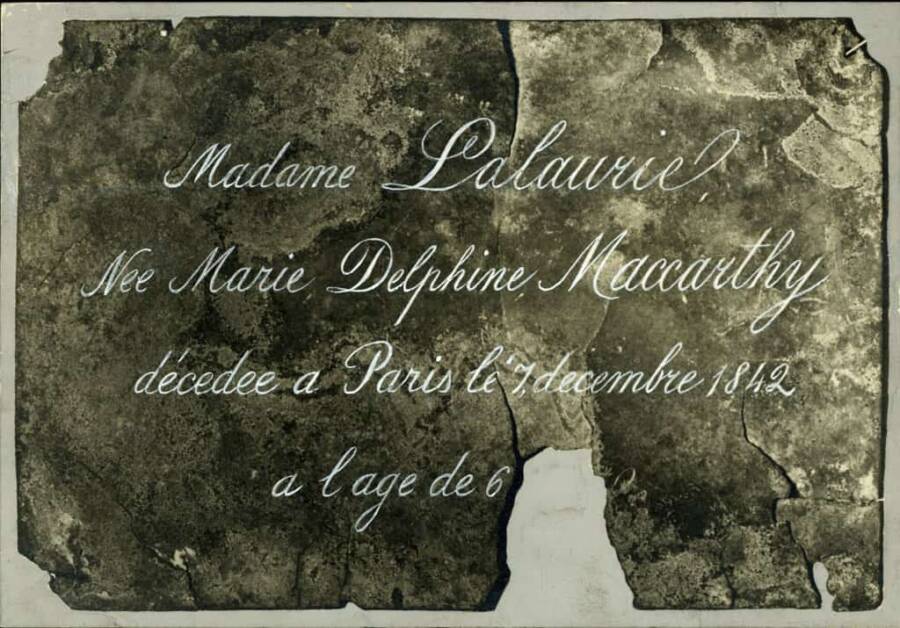
Public DomainThe epitaph purportedly discovered at St. Louis Cemetery No. 1.
By then, Madame LaLaurie’s reputation had been thoroughly destroyed. But since she had fled before she could be charged with any crimes in New Orleans — or perhaps meet vigilante justice — she got away with the horrific torture and murder of untold numbers of enslaved people. It’s difficult to say exactly how many people were victims of LaLaurie’s depravity, but some accounts say as many as 100 may have suffered at her hands.
And her rebuilt mansion in New Orleans still stands as a reminder of the horror she once inflicted there. Though Madame LaLaurie is long gone, LaLaurie Mansion is said to be one of the most haunted houses in America.
The LaLaurie Mansion Today

Wikimedia CommonsThe victims of Madame LaLaurie who were buried on or near the property are said to haunt the grounds to this day.
After the fire exposed Madame LaLaurie’s depraved torture of enslaved people, LaLaurie Mansion fell into ruins. As the years passed, it was rebuilt and then repurposed as an integrated school, a conservatory of music, a shelter for the homeless, and even apartments. In 2007, the actor Nicholas Cage briefly owned the home, though he lost it to foreclosure in 2009.
There’s perhaps a good reason why no one stays at LaLaurie Mansion for very long — it’s believed by many to be haunted.
Multiple visitors have reported hearing shrieks and moans, smelling burning flesh, and hearing the dragging of chains while exploring the building. Some even claim that they’ve seen ghosts on the property, including a large Black man in chains and a white woman with glaring eyes.
Though some of the ghosts seem harmless, there is supposedly a vindictive, violent spirit in the house. Said to be the ghost of Madame Delphine LaLaurie herself, the phantom allegedly grabbed young girls when the house was used as a school, leaving bruises and scratches on their arms.
If that story is true, then it seems that even in death, Madame LaLaurie is filled with violence and hate. Years after she inflicted unimaginable torture on enslaved people in her home, her spirit remains cruel.
After learning about Madame Delphine LaLaurie, read about Marie Laveau, New Orleans’ voodoo queen. Then, discover the stories of these famous serial killers.





